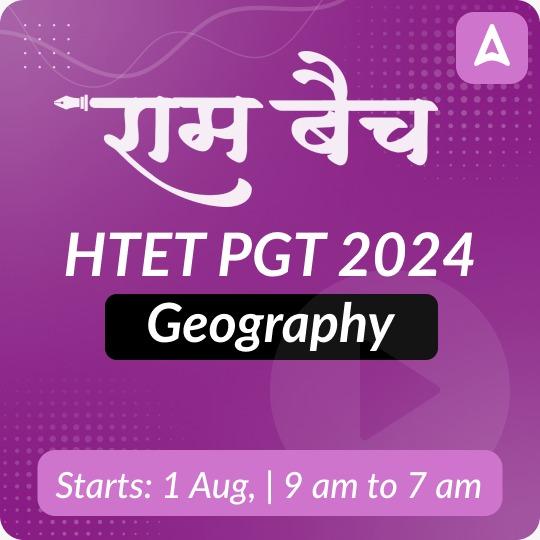Table of Contents
Geography is a popular optional subject for the UPSC Mains exam. The UPSC Geography Syllabus for 2025 covers various topics such as natural resource distribution, industrial location factors, geophysical phenomena, physical geography, and environmental geography. It is considered one of the top 10 most challenging subjects in the UPSC exam. Many students opt for Geography because the syllabus is known to be scoring.
In the UPSC Syllabus for Geography optional subject, there are two papers- Optional Paper I and Paper II, as part of the Mains stage of the IAS Exam, which consists of a total of nine papers. Below is a detailed discussion of the UPSC Geography Optional Syllabus for the Mains exam.
UPSC Geography Syllabus 2025
The Geography subject has two papers, each worth 250 marks, adding up to 500 marks. For candidates who are good at and enjoy geography, choosing it as an optional subject for the UPSC Mains exam is a smart choice. Many helpful books are available for preparation.
Each paper is split into two sections with a total of eight questions. Students need to answer five of these eight questions, including one compulsory question from the last three. Doing well in the Geography optional exam can significantly improve an IAS aspirant’s overall score in the UPSC Mains Exam.
| Aspect | Details |
| Total Papers | 2 Papers |
| Marks per Paper | 250 Marks |
| Total Marks | 500 Marks |
UPSC Geography Syllabus for Prelims
Geography is a vast field that studies the Earth’s landscapes, environments, and the relationships between people and their environments. Here’s an overview of the Geography syllabus for the Prelims Examination and topics are given below under Indian and World Geography:
UPSC Prelims Syllabus- Indian and World Geography-Physical, Social, Economic Geography of India and the World.
Indian Geography
Physical Geography
1. Physiographic Divisions- The Himalayan Region, The Northern Plains, The Peninsular Plateau, The Indian Desert, The Coastal Plains, The Islands
2. Climate- Monsoon system and its Formation Mechanism, El Nino, La Nina, Indian Ocean Dipole, Air Mass and Jetstreams, Climatic regions, Cyclones, Droughts, and Floods.
3. Rivers and Drainage Systems- Himalayan rivers: Ganga, Yamuna, Brahmaputra, etc., Peninsular rivers: Godavari, Krishna, Cauvery, etc., Inland drainage and lakes.
4. Soils- Types of soils: Alluvial, Black, Red, Laterite, etc., Soil distribution and characteristics
5. Natural Vegetation and Wildlife- Forest types: Tropical evergreen, Deciduous, Thorn, etc., National parks and wildlife sanctuaries
6. Resources- Mineral resources: Iron ore, Coal, Bauxite, etc., Energy resources: Renewable and non-renewable
Social Geography
1. Population- Demographic trends, Population distribution and density, Urbanization
2. Cultural Aspects- Languages and dialects, Religions and festivals, Ethnic groups
3. Settlements- Rural and urban settlements, Patterns and types
Economic Geography
1. Agriculture- Major crops and cropping patterns, Green Revolution and its impact
2. Industry- Major industries: Iron and Steel, Textiles, IT, etc., Industrial regions
3. Transport and Communication- Road, rail, air, and water transport, Communication networks
4. Trade- Internal and international trade, Trade policies and agreements
World Geography
Physical Geography
1. Continents and Oceans- Major landforms and water bodies, Plate tectonics and continental drift
2. Climate and Weather- Climatic zones: Tropical, Temperate, Polar, Weather patterns and phenomena
3. Biomes and Ecosystems- Forests, Grasslands, Deserts, Tundras, Biodiversity hotspots
Social Geography
1. Population- Global demographic trends, Migration and urbanization
2. Cultural Aspects- Major languages and religions, Cultural regions and diversity
3. Human Development- HDI and quality of life indicators, Education and Healthcare
Economic Geography
1. Agriculture- Types of farming: Subsistence, Commercial, Plantation, etc., Major agricultural regions
2. Industry, Industrialization, and economic development, Global industrial regions
3. Global Trade- Trade routes and agreements, Globalization and its impacts
4. Resources and Energy- Distribution of natural resources, Energy production and consumption patterns
UPSC Geography Syllabus 2025 for Mains
UPSC Geography Syllabus is a part of the official UPSC Syllabus 2025 Geography is an integral part of the General Studies (GS) Paper I in the UPSC Mains examination.
1. Distribution of key natural resources: Understanding the global distribution of natural resources, including South Asia and the Indian subcontinent. Factors influencing the location of primary, secondary, and tertiary sector industries worldwide, focusing on India.
2. Important geophysical phenomena: Studying significant geophysical events such as earthquakes, tsunamis, volcanic activities, cyclones, etc; Identifying geographical features and their locations and analyzing the impact of changes in these features on flora, fauna, and the environment.
3. Salient features of world physical geography: Exploring various aspects of physical geography, including geomorphology, climatology, oceanography, biogeography, and environmental geography.
4. Geomorphology: Examining the interior of the Earth, tectonic processes, mountain formation, volcanic activities, earthquakes, weathering, erosion, rocks, and landforms.
5. Climatology: Understanding the Earth’s atmosphere, temperature patterns, jet streams, pressure systems, wind circulation, air masses, weather fronts, cyclones, humidity, precipitation, geographical phenomena, and global climatic regions.
6. Oceanography: Studying ocean topography, temperature distribution, ocean currents, salinity variations, coral bleaching, marine pollution, sea level changes, international laws related to the oceans, and other relevant aspects.
7. Biogeography:
- soil profiles, soil degradation, soil conservation methods, biotic regions, deforestation, conservation of forests, changes in critical geographical features, and environmental pollution.
- It is important to note that there is a significant overlap between geography and environmental studies in some of the topics mentioned above.
Candidates preparing for the UPSC Mains examination should delve deeper into each area, understanding specific examples, case studies, current developments, and their implications on global and regional scales.
UPSC Geography Optional Syllabus Paper I
UPSC Geography Syllabus – Physics
1. UPSC Geography Syllabus – Geomorphology:
- Factors controlling landform development
- Endogenetic and homogeneity forces
- Origin and evolution of the Earth’s crust
- Fundamentals of geomagnetism
- Physical conditions of the Earth’s interior
- Geosynclines
- Continental drift
- Isostasy
- Plate tectonics
- Recent views on mountain building
- Volcanicity
- Earthquakes and Tsunamis
- Concepts of geomorphic cycles and landscape development
- Denudation chronology
- Channel morphology
- Erosion surfaces
- Slope development
- Applied Geomorphology
- Geomorphology, economic geology, and environment
UPSC Geography Syllabus – Climatology:
- Temperature and pressure belts of the world
- Heat budget of the earth
- Atmospheric circulation Atmospheric stability and instability
- Planetary and local winds
- Monsoons and jet streams
- Air masses and fronts
- Temperate and tropical cyclones
- Types and distribution of precipitation
- Weather and Climate
- Koppen Thorn Thwaite’s and Trewartha’s classification of world climate
- Hydrological cycle
- Global climatic change and the role and response of man in climatic changes
- Applied climatology and urban climate
UPSC Geography Syllabus – Oceanography:
- Bottom topography of the Atlantic, Indian, and Pacific Oceans
- Temperature and salinity of the oceans
- Heat and salt budgets
- Ocean deposits
- Waves, currents, and tides
- Marine resources (biotic, mineral, and energy resources)
- Coral reefs and coral bleaching
- Sea-level changes
- Law of the sea and marine pollution
UPSC Geography Syllabus – Biogeography:
- Genesis of soils
- Classification and distribution of soils
- Soil profile
- Soil erosion, degradation, and conservation
- Factors influencing the world distribution of plants and animals
- Problems of deforestation and conservation measures
- Social forestry and agro-forestry
- Wildlife
- Major gene pool centres
UPSC Geography Syllabus – Environmental Geography
- Principles of ecology
- Human ecological adaptations
- Influence of Man on Ecology and Environment
- Global and regional ecological changes and imbalances
- Ecosystem management and conservation
- Environmental degradation, management, and conservation
- Biodiversity and sustainable development
- Environmental policy
- Environmental hazards and remedial measures
- Environmental education and legislation
UPSC Geography Syllabus – Human Perspectives:
- Areal differentiation: The study of spatial variations and differences in human phenomena across different areas or regions.
- Regional synthesis: The process of integrating and synthesizing diverse information and data to gain a comprehensive understanding of a particular region.
- Dichotomy and dualism: Exam of contrasting and often interconnected pairs of concepts or phenomena, such as urban-rural, developed-underdeveloped, or global-local.
- Environmentalism: The perspective that emphasizes the relationship between humans and their environment, and the impacts of human activities on the natural world.
- Quantitative revolution and locational analysis: The use of quantitative methods and spatial analysis techniques to study human geography, focusing on the locational patterns of various phenomena.
- Radical, behavioural, human, and welfare approaches: Different theoretical approaches that emphasize social, cultural, economic, or political factors in understanding human geography, ranging from radical perspectives to those centred on individual behaviour, human agency, or social welfare.
- Languages, religions, and secularization: The study of the distribution, diversity, and influence of languages and religions in different regions, as well as the processes of secularization and its impact on societies.
- Cultural regions of the world: The identification and analysis of regions characterized by shared cultural traits, including language, religion, customs, traditions, and artistic expressions.
- Human Development Index: A composite measure that assesses the overall well-being and development of countries based on indicators such as life expectancy, education, and income.
UPSC Geography Syllabus – Economic:
- World economic development: The study of global economic systems, their measurement, and the challenges and disparities in economic development across different countries and regions.
- World resources and their distribution: Examination of the spatial distribution of natural resources, such as minerals, energy sources, water, and agricultural land, and their implications for economic activities.
- Energy crisis and the limits to growth: The analysis of global energy challenges, including issues related to resource depletion, environmental impacts, and the need for sustainable energy alternatives. The concept of the “limits to growth” refers to the idea that there are ecological and resource constraints that can restrict long-term economic growth.
- World agriculture: A typology of agricultural regions: The classification and study of different agricultural systems and regions, considering factors like climate, soil, crops, farming practices, and their relationship with food production and rural economies.
- Agricultural inputs and productivity: The exam factors that contribute to agricultural productivity, including inputs like fertilizers, machinery, and technology, as well as the impacts of agricultural practices on the environment.
- Food and nutrition problems, food security, famine: The study of issues related to access to sufficient, safe, and nutritious food, including problems such as food shortages, malnutrition, food security, and famine, along with their causes, effects, and potential remedies.
- World Industries: Location patterns and problems: The analysis of the spatial distribution of industrial activities worldwide, including factors influencing location decisions, clustering of industries, and challenges related to industrial development and sustainability.
- Patterns of world trade: The study of global trade flows, patterns, and networks, including the spatial distribution of trade, the role of multinational corporations, trade agreements, and the impacts of globalization on economic geography.
UPSC Geography Optional Syllabus – Population and Settlement:
- Growth and distribution of world population: Examination of global population growth trends, patterns, and distribution across different regions and countries.
- Demographic attributes: The study of population characteristics, including age structure, gender, fertility rates, mortality rates, migration patterns, and their implications for social and economic development.
- Causes and consequences of migration: Analysis of the factors driving migration, such as economic opportunities, political conflicts, environmental factors, and the social, economic, and cultural impacts of migration on sending and receiving regions.
UPSC Geography Optional Syllabus Paper II
- Physical Setting: Space relationship of India with neighbouring countries; Structure and relief; Drainage system and watersheds; Physiographic regions; Mechanism of Indian monsoons and rainfall patterns; Tropical cyclones and western disturbances; Floods and droughts; Climatic regions; Natural vegetation, Soil types, and their distributions.
- Resources: Land, surface and ground water, energy, minerals, biotic and marine resources, Forest and wildlife resources and their conservation; Energy crisis.
- Agriculture: Infrastructure: irrigation, seeds, fertilizers, power; Institutional factors; land holdings, land tenure and land reforms; Cropping pattern, agricultural productivity, agricultural intensity, crop combination, land capability; Agro and social-forestry; Green revolution and its socio-economic and ecological implications; Significance of dry farming; Livestock resources and white revolution; Aquaculture; Sericulture, Agriculture, and poultry; Agricultural regionalization; Agro-climatic zones; Agroecological regions.
- Industry: Evolution of industries; Locational factors of cotton, jute, textile, iron and steel, aluminium, fertilizer, paper, chemical and pharmaceutical, automobile, cottage, and ago-based industries; Industrial houses and complexes including public sector undertakings; Industrial regionalization; New industrial policy; Multinationals and liberalization; Special Economic Zones; Tourism including ecotourism.
- Transport, Communication, and Trade: Road, railway, waterway, airway, and pipeline networks and their complementary roles in regional development; Growing importance of ports on national and foreign trade; Trade balance; Trade Policy; Export processing zones; Developments in communication and information technology and their impacts on economy and society; Indian space program.
- Cultural Setting: Historical Perspective of Indian Society; Racial linguistic and ethnic diversities; Religious minorities; Major tribes, tribal areas, and their problems; Cultural regions; Growth, distribution, and density of population; Demographic attributes: sex-ratio, age structure, literacy rate, work-force, dependency ratio, longevity; migration (inter-regional, intraregional and international) and associated problems; Population problems and policies; Health indicators.
- Settlements: Types, patterns, and morphology of rural settlements; Urban developments; Morphology of Indian cities; Functional classification of Indian cities; Conurbations and metropolitan regions; Urban sprawl; Slums and associated problems; Town planning.
- Regional Development and Planning: Experience of regional planning in India; Five Year Plans; Integrated rural development programmers; Panchayati Raj and decentralized planning; Command area development; Watershed management; Planning for backward area, desert, drought-prone, hill tribal area development; multi-level planning; Regional planning and development of island territories.
- Political Aspects: Geographical basis of Indian federalism; State reorganization; Emergence of new states; Regional consciousness and inter-state issues; International boundary of India and related issues; Cross-border terrorism; India’s role in world affairs; Geopolitics of South Asia and Indian Ocean realm.
- Contemporary Issues: Ecological issues: Environmental hazards: landslides, earthquakes, Tsunamis, floods and droughts, epidemics; Issues related to environmental pollution; Changes in patterns of land use; Principles of environmental impact assessment and environmental management; Population explosion and food security; Environmental degradation; Deforestation, desertification, and soil erosion; Problems of agrarian and industrial unrest; Regional disparities in economic development; Concept of sustainable growth and development; Environmental awareness; Linkage of rivers; Globalizations and Indian economy.
UPSC Geography Syllabus Preparation Tips
Candidates can check some of the preparation resources added to you like using books and newspapers. You can use online resources through different web portals and platforms. Solve UPSC Previous Year questions to build a strong understanding of these topics.
- Read NCERT Books
- Analyze Previous Years’ Papers
- Create a Study Plan
- Current Affairs
- Focus on Key Concepts
- Practice Answer Writing
Note that consistency, discipline, and a thorough understanding of concepts are key to success in the UPSC Mains Geography examination. Good luck with your preparation.









 TSPSC Group 1 Question Paper 2024, Downl...
TSPSC Group 1 Question Paper 2024, Downl...
 TSPSC Group 1 Answer key 2024 Out, Downl...
TSPSC Group 1 Answer key 2024 Out, Downl...
 UPSC Prelims 2024 Question Paper, Downlo...
UPSC Prelims 2024 Question Paper, Downlo...




